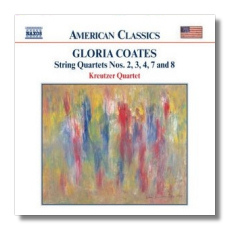
The Internet's Premier Classical Music Source
Related Links
- G. Coates Reviews
- Latest Reviews
- More Reviews
-
By Composer
-
Collections
DVD & Blu-ray
Books
Concert Reviews
Articles/Interviews
Software
Audio
Search Amazon
Recommended Links
Site News
 CD Review
CD Review
Gloria Coates

String Quartets
- String Quartet #2 (1972)
- String Quartet #3 (1975)
- String Quartet #4 (1976)
- String Quartet #7 "Angels" (2000)
- String Quartet #8 (2001-02)
Kreutzer Quartet
Philip Adams, organ
Michael Finnissy, conductor
Naxos 8.559152 DDD 64:37
Michigan-born composer Gloria Coates has lived in Germany for most of the past three decades. A handful of CDs on the Naxos, cpo, and New World labels has piqued the curiosity of a new audience lately. An excellent interview with Coates describes her music as characterized by "glacial semitonal and modal shifts, clustered chord progressions, hair-raising glissandi, and nonredemptive climaxes." Sometimes her music – rich in glissandi and sonoristic effects – has been compared to Penderecki's early work, but Coates remarks that she arrived at her style independent of the so-called "Polish School." Coates's works might be called difficult and even frightening because she, like Charles Ives, is evidently uninterested in writing "nice" music. In the Neveldine interview, she comments, "My music expresses my inner world. I am not aware of its being terrifying, although it does express very basic feelings of life and death and joy as well as anxiety and pain."
Her First, Fifth, and Sixth string quartets was released by Naxos (8.559091) in May 2002. This new release completes the set – at least until she composes a Ninth.
The Second String Quartet was composed in 1972 and lasts just a little over six minutes. Canonic writing – quite common in Coates's work – is the basis for this work, although it is hard for the ear to follow because of Coates's heavy use of outline-blurring glissandi. The Third Quartet (1975) also uses canonic writing in its middle movement. In the opening movement, each instrument has its own ostinato figure which is repeatedly transposed upwards as the movement progresses. After a painful solo for viola, the finale develops into a brutal mass of swirling, angry sound. The Fourth Quartet (1976) is in some ways a mirror of the Third. Here, ostinatos play an important role in the final movement, and it is the first movement that is dramatically colored by Coates's signature glissandos. Annotator Kyle Gann appropriately compares the middle movement to one of Bartók's "night music" pieces.
"Angels," the Seventh Quartet (2000), is especially interesting because this work includes an organ part. Clusters and glissandi again dominate, but the organ textures give this quartet a heavy sound of its own. Disguised quotations from Christmas carols drift in and out. Obviously Coates sees angels as powerful and mysterious entities, not as the sweet and gauzy beings that dominate popular culture. And finally, the Eighth Quartet (2001-02) was written in the wake of the destruction of the World Trade Center. Here the movements have English titles: "On wings of sound," "In falling timbers buried," and "Prayer." Again, the first movement is a canon that is undecipherable to the ear because of the dominance of emotion-laden glissandi. Sinking glissandi in the second movement do suggest "falling timbers." The final movement is based on chords of parallel fifths. The tumult has at last been quieted, but it unclear whether the prayers have been heard.
As on the earlier release, the Kreutzers play this difficult music with commitment and abandon, and there is good work from Adams and Finnissy too. Naxos provides fine engineering, and Gann's booklet note is helpful. The booklet cover reproduces one of Coates's own paintings, which look like her music sounds!
Copyright © 2004, Raymond Tuttle


















